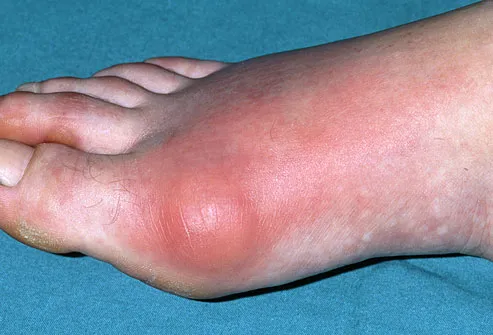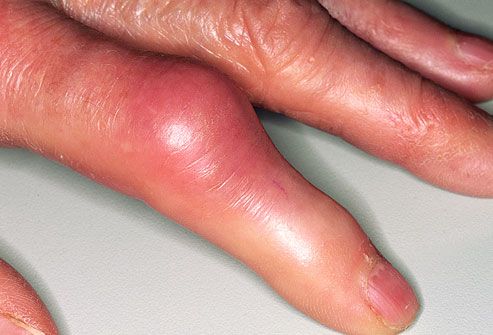Causes
Gout is caused initially by an excess of uric acid in the blood, or hyperuricemia. Uric acid is produced in the body during the breakdown of purines – chemical compounds that are found in high amounts in certain foods such as meat, poultry, and seafood.
Normally, uric acid is dissolved in the blood and is excreted from the body in urine via the kidneys. If too much uric acid is produced, or not enough is excreted, it can build up and form needle-like crystals that trigger inflammation and pain in the joints and surrounding tissue.


Symptoms
Gout usually becomes symptomatic suddenly without warning, often in the middle of the night.
The main symptoms are intense joint pain that subsides to discomfort, inflammation, and redness.
Gout frequently affects the large joint of the big toe, but can also affect the ankles, knees, elbows, wrists, and fingers.
TYPES
There are various stages through which gout progresses, and these are experienced as the different types of gout.
Asymptomatic hyperuricemia
It is possible for a person to have elevated uric acid levels without any outward symptoms. At this stage, treatment is not required, though urate crystals are being deposited in tissue and causing slight damage.
People with asymptomatic hyperuricemia may be advised to take steps to address any possible factors contributing to uric acid build-up.
Acute gout
This stage occurs when the urate crystals that have been deposited suddenly cause acute inflammation and intense pain. This sudden attack is referred to as a “flare” and will normally subside within 3 to 10 days. Flares can sometimes be triggered by stressful events, alcohol and drugs, as well as cold weather.
Interval or intercritical gout
This stage is the period in between attacks of acute gout. Subsequent flares may not occur for months or years, though if not treated, over time, they can last longer and occur more frequently. During this interval, further urate crystals are being deposited in tissue.
Chronic tophaceous gout
Chronic tophaceous gout is the most debilitating type of gout. Permanent damage may have occurred in the joints and the kidneys. The patient can suffer from chronic arthritis and develop tophi, big lumps of urate crystals, in cooler areas of the body such as the joints of the fingers.
It takes a long time without treatment to reach the stage of chronic tophaceous gout – around 10 years. It is very unlikely that a patient receiving proper treatment would progress to this stage.
Pseudogout
One condition that is easily confused with gout is pseudogout. The symptoms of pseudogout are very similar to those of gout.
The major difference between gout and pseudogout is that the joints are irritated by calciumphosphate crystals rather than urate crystals. Pseudogout requires different treatment to gout.
Treatment

Gout patients often have acute inflammation around their joints.
The majority of gout cases are treated with medication. Medication can be used to treat the symptoms of gout attacks, prevent future flares, and reduce the risk of gout complications such as kidney stones

Post a comment